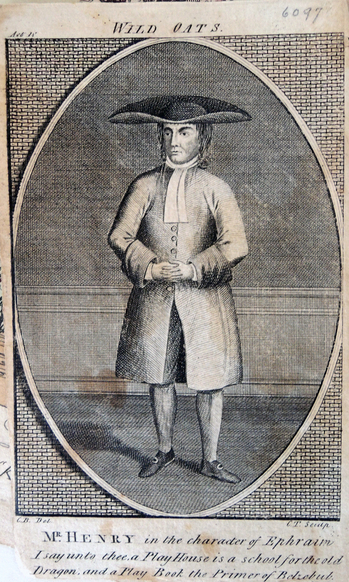Wild Oats. Act IV, no date [1793]. Engraving. Graphic Arts
TC096 Theater Pictures Collection.
By the time the Irish playwright John O’Keeffe (1747-1833) wrote his most famous farce Wild Oats; or, The Strolling Gentlemen in 1791, he was already a celebrated author. Within two years, the Old American Company in New York City staged a production and an American edition of the play was printed by T. and J. Swords for Manhattan bookseller and stationer John Reid. To decorate the volume, American engraver Cornelius Tiebout was commissioned to create a frontispiece (seen here).
According to the historian D. M. Stauffer, Tiebout was the “first American-born professional engraver to produce really meritorious work, …significant for his role in introducing the English method of stippled portraiture to America.” Like many early printmakers, Tiebout apprenticed to a silversmith where he learned to carve in metal. Further training with the British artist James Heath led to his expertise in stipple engraving.
It is notable that Tiebout chooses to illustrate one of the humorous supporting characters rather than the leading man. His print offers a full-length portrait of the Quaker Ephraim Smooth and quotes his lines, “Why dost thou suffer him to put into the hands of thy servants, books of tragedies, and books of comedies, prelude, interlude, yea, all lewd. My spirit doth wax wrath.— I say unto thee, a play-house is the school for the old dragon, and a playbook the primer of Belzebub.”
For a contemporary production of Wild Oats, see:
Other sources on Tiebout: W. Dunlap: A History of the Rise and Progress of the Arts of Design in the United States (New York, 1834); American Engravers upon Copper and Steel, 3 vols (i-ii, New York, 1907; iii, Philadelphia, 1917), i, pp. 271-2; ii, pp. 520-33; iii, pp. 271-84 [vols i-ii by D. M. Stauffer, vol. iii by M. Fielding]; N. E. Cunningham jr: The Image of Thomas Jefferson in the Public Eye: Portraits for the People, 1800-1809 (Charlottesville, VA, 1981) [disc. of Tiebout’s Jefferson prts, incl. newspaper advertisements and publishers’ corr.]; W. C. Wick: George Washington, an American Icon: The Eighteenth-century Graphic Portraits (Washington, DC, 1982) and G. W. R. Ward, ed.: The American Illustrated Book in the Nineteenth Century (Winterthur, DE, 1987).
